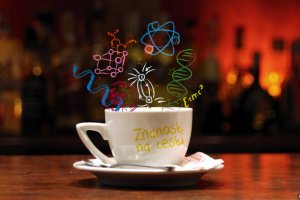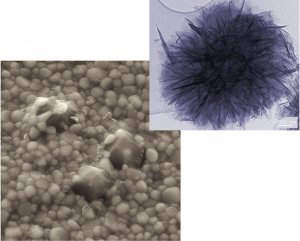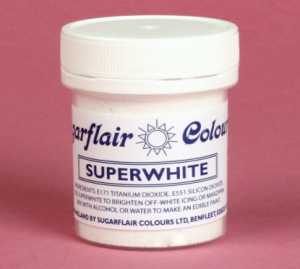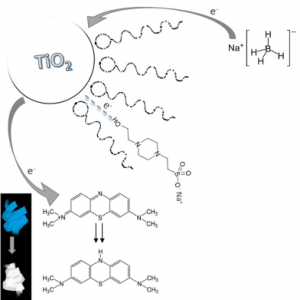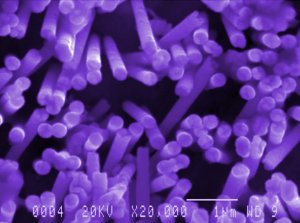Materials for regenerative medicine
Cells used in tissue engineering need a certain environment that provides attachment, mechanical support, nutrition flow. Such support can be provided by scaffolds made of biocompatible and biodegradable materials. Research in our group is focused on natural biomaterials that can be used in scaffolds, films or bioinks for the treatment of osteochondral, bone defects, and for wound treatments. Scaffolds properties, such as rate of degradation, porosity, bioactivity are tailored by materials chemical and physical properties. Therefore, our aim is to understand the relation between them.
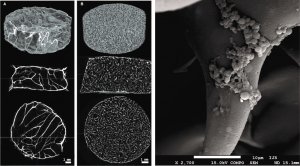
Projects: ARRS – Bioactive glass-based composite scaffolds for tissue engineering applications, MZS – 3D bioactive glass and biopolymer scaffolds for treatment of osteochondral defects developed due to articular cartilage lesions
Drnovšek, R. Kocen, A. Gantar, M. Drobnič-Košorok, A. Leonardi, I. Križaj, A. Rečnik, S. Novak, Size of silk fibroin b-sheet domains affected by Ca2+. Journal of materials chemistry B, 6 (2016) 14
Gantar, N. Drnovšek, P. Casuso A. Perez-San Vicente, J. Rodriguez, D. Dupin, S. Novak, I. Loniaz. Injectable and self-healing dynamic hydrogel containing bioactive glass nanoparticles as a potential biomaterial for bone regeneration. RSC advances, 6, (2016) 69156
Contact:
Dental ceramics, root end feelings
The optimal root end filling material should provide several characteristics; biocompatibility, marginal sealing, long enough setting time, and should effectively eliminate bacteria, and induce bone repair. In collaboration with a dental clinic, Ustna Medicina d.o.o. new antibacterial and bioactive composite MTA based cement materials are being developed. Research is focused on controlling the rheology and hydration time of composite by the addition of new components, such as bioactive glass, that also induce bioactivity and help to prolong the antibacterial effect.
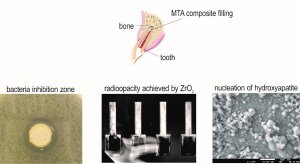
Project: Research and development of MTA for Ustna medicina d.o.o.
Contact:
Bioactive glass and bioceramics
Bioactive glass is known as amorphous degradable highly bioactive material that promotes bone growth. By using particulate sol-gel technique nanosized bioactive glass can be produced. Such glass has high bioactivity and solubility due to nanosized particles and high porosity. When used as a coating on titanium implants it promotes bone ingrowth and prevents loosening of an implant. When used as a composite in teeth whitening agent it helps to reduced teeth hypersensitivity by regrowing dentine tubules with hydroxyapatite. It can also be used in regenerative medicine as it completely dissolves when in contact with body fluids.
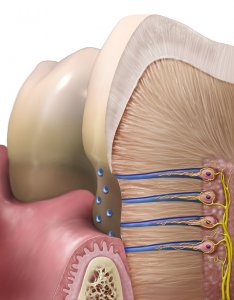
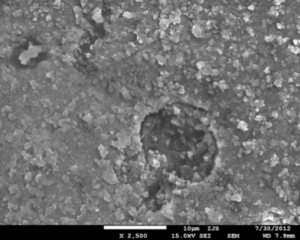
Contact:
3D bioprinting
Tissue regeneration has advanced to the point where 3D printing provides a valuable addition to the field. Printing natural, biodegradable materials gives the possibility of creating patient-specific cell scaffolds that could regenerate damaged tissue or even organs.
We have modified a commercial 3D printer to be able to print hydrogel materials. The printer’s modified hot-end is able to hold up to 30 ml of solution preheated up to 90 °C and extrude it on a heated or cooled bed (down to 10 °C). The printer can also work using standard thermoplastic materials.
Development of bioinks for 3D bioprinting is currently under research. We are working on gellan gum and silk fibroin hydrogels. Using rheometry, we are able to determine the flowing properties of the bioink solution, temperature, and speed of gelation as well as final mechanical properties of the printed bioink. This allows us to determine the most suitable composition of the bioink prior to printing.
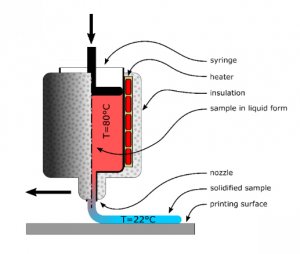
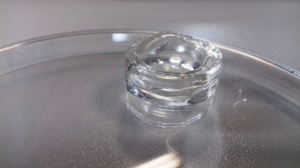
R. Kocen, M. Gasik, A. Gantar, S. Novak, Viscoelastic behaviour of hydrogel-based composites for tissue engineering under mechanical load, Biomed. Mater. 12 (2017) 25004.
Contact:
Nanoparticles in food, safe food
Project: ISO-FOOD – ERA Chair for isotope techniques in food quality, safety and traceability, 621329.
Lorenzetti, A. Drame, S. Šturm and S. Novak, “TiO2 (nano)particles extracted from sugar-coated confectionery,” Journal of nanomaterials, 2 (2017) 6298307-1-6298307-14
Novak, M. Lorenzetti, A. Drame, J. Vidmar, J. Ščančar and M. Filipič, ” Diversity of TiO2 nanopowders’ characteristics relevant to toxicity testing,” Journal of nanoparticle research, 18 (2016) 130-1-130-13,
Contact:
Multi-functional/hybrid nanoparticles for photo-thermal cancer treatment and imaging
Due to the high mortality cancer has become one of the major issues of an aging population. In order to improve the patient survival, reduce the treatment time and the unwanted side effects, a radically new approaches in the treatment and the diagnostics are needed. To realize this, we are focusing on the developement of the multi-functional hybrid nanoparticles as an innovative »theranostic« system (= therapy + diagnostics).
- Optimized FePt magnetic nanoparticles as the core material (single-core or multi-core) serve as an excellent contrast agent for MRI and enable magnetic manipulation when exposed to the external magnetic field.
- Plasmonically active Au nano-shells are used for the efficient photo-thermal cancer treatment using low-energy NIR laser light.
- As-prepared hybrid nanoparticles are selectively uptaken by the the cancer cells (urothelial RT4 cell line), while the uptake by the normal cells is minimal, which was shown to be crucial for the selective and efficient photo-thermal cancer treatment.
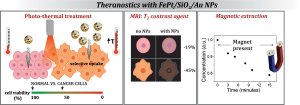
Kostevšek N et al. (2015) Multimodal hybrid FePt/SiO2/Au nanoparticles for nanomedical applications: combining photothermal stimulation and manipulation with an external magnetic field. J. Phys. Chem. C 119:16374-16382.
Kostevšek N et al. (2015) “Single- and “multi-core” FePt nanoparticles: from controlled synthesis via zwitterionic and silica biofunctionalization to MRI applications. J. Nanopart. Res. 17: 464.
Kostevšek N et al. (2016) The One-Step Synthesis and Surface Functionalization of Dumbbell-Like Gold-Iron Oxide Nanoparticles. A Chitosan-Based Nanotheranostic System. Chem. Comm. 52: 378-381.
Kostevšek N et al. (2017) Hybrid FePt/SiO2/Au nanoparticles as theranostic tool: in vitro photo-thermal treatment and MRI imaging, Nanoscale (just accepted).
This study was supported by the Slovenian Research Agency ARRS (project number J2-6760, S. Šturm, »Bio-responsive magneto-optically coupled nanomaterial-based systems for innovative skin cancer treatments«).
Contact:
Developement of multi-functional hybrid liposomes for active cancer treatment and multimodal diagnostics
By encapsulating the cytotoxic drug in a smart drug delivery system with the prolonged circulation time, the efficiency of the chemotherapy can be strongly increased with decreasing potential side effects. Liposomes are assumed to be one of the safest drug delivery systems proposed so far. Moreover, by adding different active components either in the core or in the bilayer of the liposomes a safe and efficient multi-functional drug delivery system can be prepared.
- Innovative combination of liposomes and photo-thermally active components (nanoparticles and highly absorbing dye molecules) enables controlled remotely-triggered drug release and photo-thermal cancer treatment
- Moreover, as-prepared magneto-liposomes, i.e. liposomes containing magnetic nanoparticles, have a great potential to be used as the efficient MRI contrast agent and with a special design can even surpass the MRI performance of the non-liposomal magnetic nanoparticles.
- Increased safety and selectivity of the treatment can be achieved using the targeting ligand on the surface of the liposomes for the active targeting of the cancer cells.

